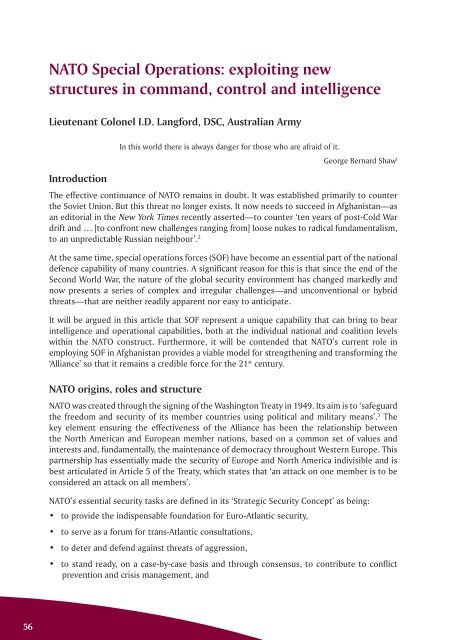ISSUE 183 : Nov/Dec - 2010 - Australian Defence Force Journal
ISSUE 183 : Nov/Dec - 2010 - Australian Defence Force Journal
ISSUE 183 : Nov/Dec - 2010 - Australian Defence Force Journal
You also want an ePaper? Increase the reach of your titles
YUMPU automatically turns print PDFs into web optimized ePapers that Google loves.
NATO Special Operations: exploiting newstructures in command, control and intelligenceLieutenant Colonel I.D. Langford, DSC, <strong>Australian</strong> ArmyIntroductionIn this world there is always danger for those who are afraid of it.George Bernard Shaw lThe effective continuance of NATO remains in doubt. It was established primarily to counterthe Soviet Union. But this threat no longer exists. It now needs to succeed in Afghanistan—asan editorial in the New York Times recently asserted—to counter ‘ten years of post-Cold Wardrift and … [to confront new challenges ranging from] loose nukes to radical fundamentalism,to an unpredictable Russian neighbour’. 2At the same time, special operations forces (SOF) have become an essential part of the nationaldefence capability of many countries. A significant reason for this is that since the end of theSecond World War, the nature of the global security environment has changed markedly andnow presents a series of complex and irregular challenges—and unconventional or hybridthreats—that are neither readily apparent nor easy to anticipate.It will be argued in this article that SOF represent a unique capability that can bring to bearintelligence and operational capabilities, both at the individual national and coalition levelswithin the NATO construct. Furthermore, it will be contended that NATO’s current role inemploying SOF in Afghanistan provides a viable model for strengthening and transforming the‘Alliance’ so that it remains a credible force for the 21 st century.NATO origins, roles and structureNATO was created through the signing of the Washington Treaty in 1949. Its aim is to ‘safeguardthe freedom and security of its member countries using political and military means’. 3 Thekey element ensuring the effectiveness of the Alliance has been the relationship betweenthe North American and European member nations, based on a common set of values andinterests and, fundamentally, the maintenance of democracy throughout Western Europe. Thispartnership has essentially made the security of Europe and North America indivisible and isbest articulated in Article 5 of the Treaty, which states that ‘an attack on one member is to beconsidered an attack on all members’.NATO’s essential security tasks are defined in its ‘Strategic Security Concept’ as being:• to provide the indispensable foundation for Euro-Atlantic security,• to serve as a forum for trans-Atlantic consultations,• to deter and defend against threats of aggression,• to stand ready, on a case-by-case basis and through consensus, to contribute to conflictprevention and crisis management, and56
















